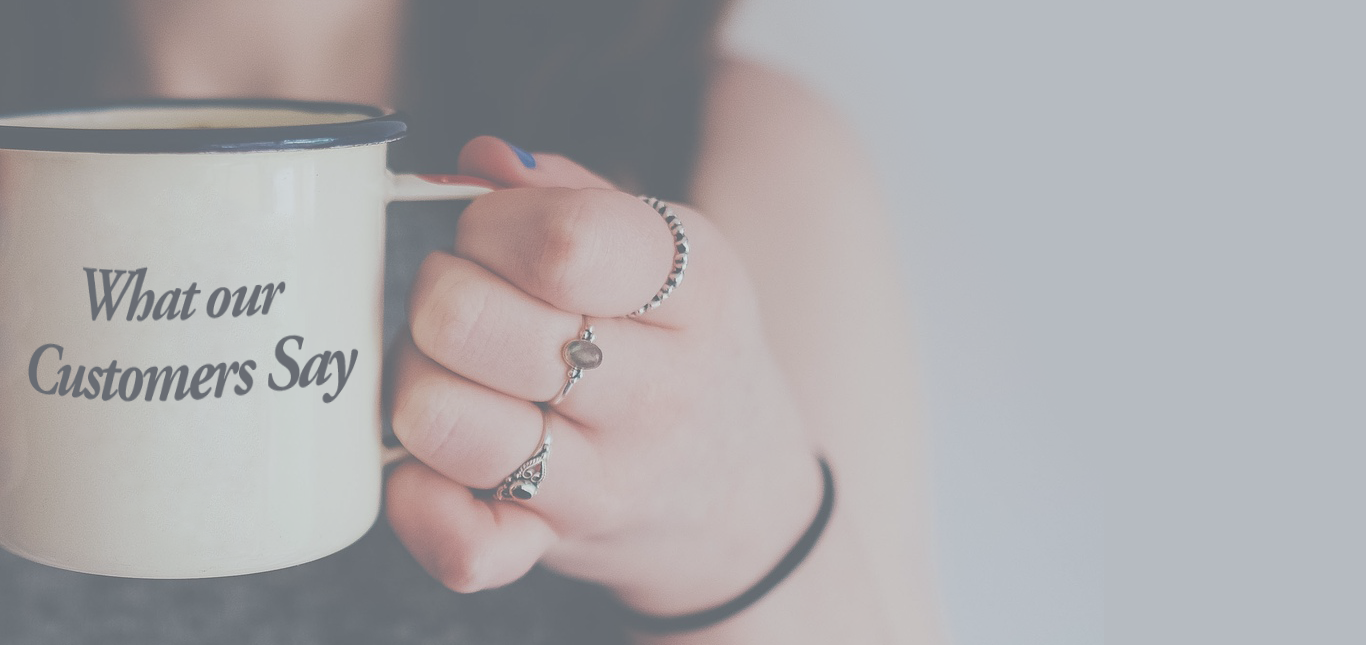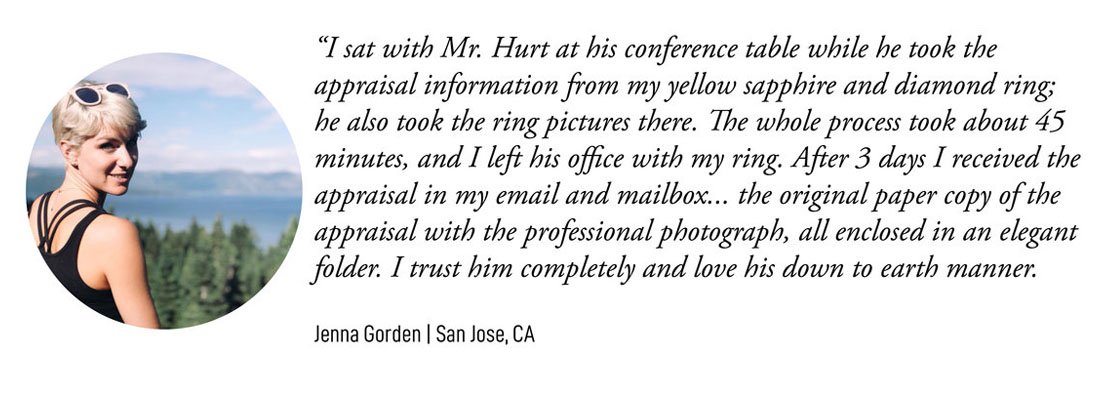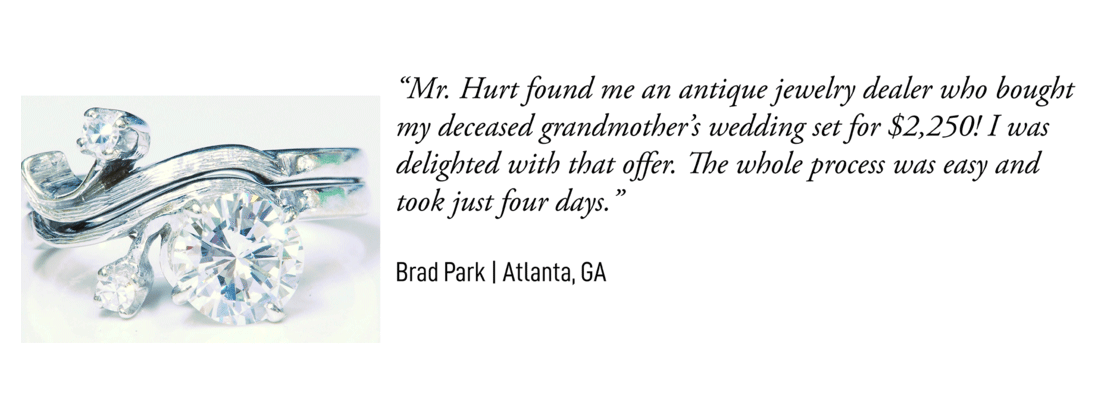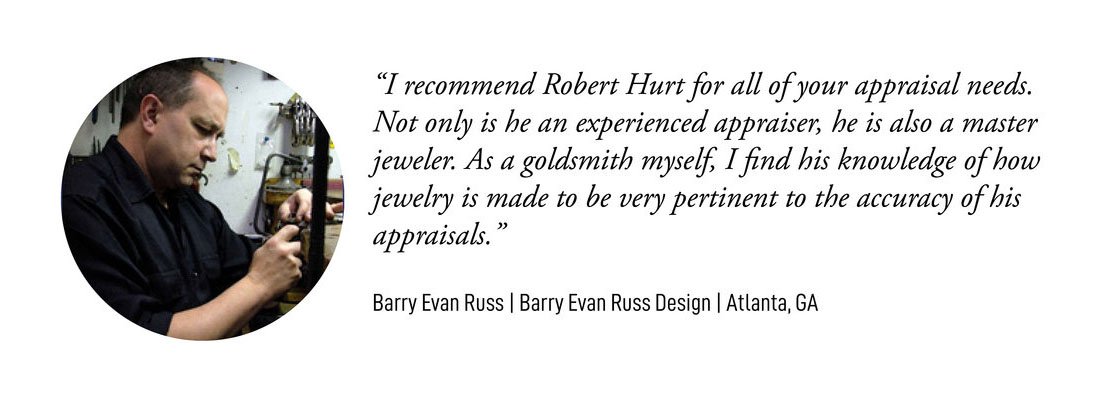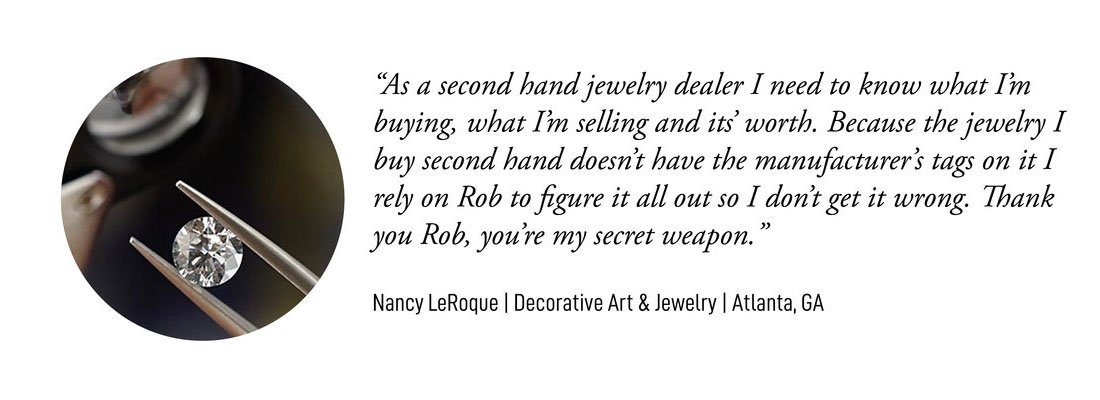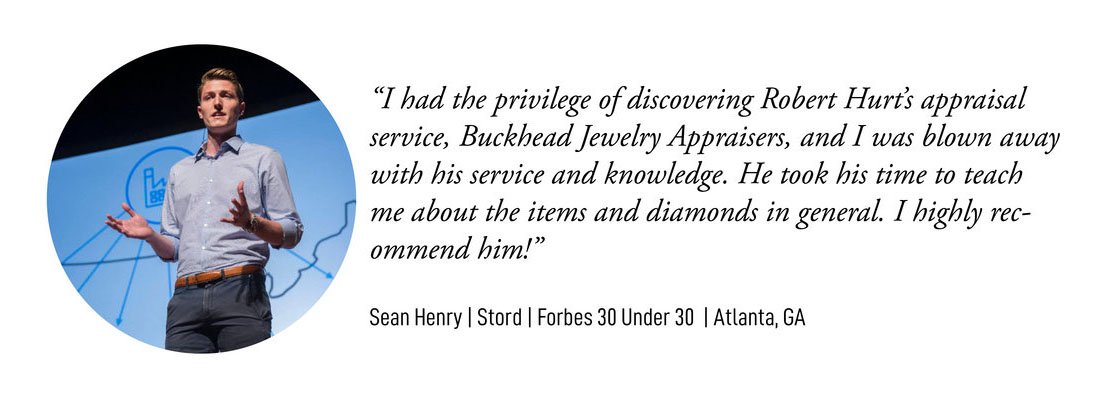
-
Yes, according to the leading diamond experts at Stuller, Inc. They are saying that if you buy a new ring containing 8 “natural-mined diamonds” it is likely that one of them is actually a “lab-grown diamond”.
-
Your appraisal will be composed by myself, Robert Hurt, G.G., A.J.P., Gemologic Institute of America Graduate Gemologist, and Gemological Institute of America Accredited Jewelry Professional. I am a member of the National Association of Jewelry Appraisers. I have been a G.I.A. Graduate Gemologist since 1986. I have 35 years of experience.
-
By appointment only.
-
No. During our appointment we sit together at my conference table while I examine your jewelry pieces and I take written notes and photographs while you watch and ask questions. Your jewelry never leaves your sight. At the end of your appointment, you take your jewelry home with you. I use my written notes and photographs to construct your appraisal(s). You do not leave your jewelry with me.
-
I provide higher quality appraisals, service and overall experience compared to other appraisers. I am one of the very few Gemologist at any price who you get to sit with and watch your appraisal work being done and then take your jewelry home with you when our appointment is finished.
-
No. My fees are mid-priced and I think my fees are a bargain. Other appraisers who offer mid-priced appraisals generally do not include photographs of your jewelry or detailed descriptions of your jewelry. They don't have much in the way of formal training or credentials. For example, if you don't already have a lab report with your diamond then other mid-priced appraisers will not be able to tell if your diamond is lab-grown or natural-mined because they don't have the high-tech testing equipment necessary for that. Also, I offer a 10% discount on every appraisal for the promise of a single Google Review.
-
Since 1986.
-
The G.I.A is the Gemological Institute of America. They are the non-profit branch of the jewelry industry. They are about 70 years old and they invented the diamond grading system. They issue lab reports on diamonds and colored gems and they operate a school to teach people how to be gemologists. Their highest degree program is called Graduate Gemologist. The G.l.A. is known as the world's foremost authority in gemology.
-
Yes. Lab-grown and natural-mined diamonds are chemically, optically, and physically the same. Both kinds grow as rough crystals and must be cut to their final shape. I have the GIA iD 100 Spectrometer in my office necessary to separate them. You want to know which one you have because the lab-grown diamonds are selling for less than half the price of the natural-mined diamond.
-
I do not remove any of your gems for any testing, including the spectrometer test. I encourage you to watch me test your diamonds with my spectrometer and we can see together if your diamonds are natural-mined or lab-grown. The spectrometer will also point out to us which, if any, of your "Diamonds" are not really diamonds. They may prove to be moissanites, CZ's, glass or something else altogether like clear topaz for example.
-
The estimated retail insurance replacement value for a piece of jewelry based on the average of what fine independent retail jewelry stores in the Atlanta, Georgia, and surrounding areas would sell a comparable item for. The appraised retail value is excluding any taxes.
-
They should be a real G.l.A. Graduate Gemologist, they should be a member of N.A.J.A., (National Association of Jewelry Appraisers), they should have a high Google Review score, and they should have 10 years of experience.
-
A good general rule is to get a jewelry appraisal when you first buy a piece of jewelry and then update your appraisal every 5 years. Should you suffer a loss your insurance company will refer to your last appraisal to help settle your claim. Consult with your insurance company for their requirements.
-
No. I do not disclose any customer information. Your privacy is assured
-
Each appointment takes 20 to 45 minutes for me to take my notes and pictures of your item, all while you wait and watch. The time it takes me depends on the complexity of the item(s). I hand you your jewelry back and then your official written appraisal will be ready in 5 to 7 business days. I email you the appraisal first and then put your written appraisal copy in the mail to you.
-
The fair market value (FMV) for a piece of jewelry is based on my research of the secondary marketplaces (used jewelry marketplaces} for a comparable item(s). Exactly which secondary marketplaces depends upon the item, of course, but can include places like current asking prices at antique fairs, results from sales at auction houses, eBay, various estate jewelry websites, discussions with colleagues, and Polygon. Other factors go into determining the value as well. For example, if the item was owned by a famous person. The appraisal price is excluding any taxes or any commissions that may be expected with the sale of the item.
-
No, because taxes vary widely, and for some purchases the seller collects no taxes at all like certain internet purchase and out-of-state purchases.
-
Yes. The details of the item will be accurate; however, it is important to note the fact that, generally speaking, insurance replacement values are higher than what the item would resell for.
-
My written appraisals start at $175.00 per item such as a ¾ carat solitaire engagement ring and will go higher if the item is complex or will take extensive research. I discuss my appraisals fees with you at the beginning of your appointment after I have looked-over what you have brought me. I don’t offer free written appraisals, I’m sorry about that, but you can get a 10% discount of my appraisal fees on all of your written appraisals by simply agreeing to leave me a single Google review.
-
Most of the time. I highly recommend my “Sell Your Jewelry” seller’s consultation so you will know for sure what you have and what it’s really worth right now on today’s secondary market. Besides just discussing the value I will discuss with you the important details of how I arrived at those numbers, such maker’s marks, item condition, rarity, weights and qualities of the diamonds, and the desirability of your item. All during our meeting your item stays on the conference table and never leaves your sight, and you leave the appointment with your jewelry. If you need help selling your item(s) I use my notes and pictures that I take of your jewelry to show to qualified second hand jewelry dealers and auction houses. When I find an interested buyer or auction house, I act as a mediator to put the interested party, and you the seller, together.
-
Gold prices are up but regular white diamond prices have started to trend down. I believe the prices for second-hand jewelry are stronger now than they will likely be later as I am seeing new lab-grown diamonds flooding into the market. Lab-grown diamonds are real diamonds, just made by man, and they are selling at 1/3rd of the price of natural-mined-out-of-the-ground diamonds, of the same quality. The lower that lab-grown prices go the fewer the number buyers there will be who will pay more for second hand natural-mined diamonds. The exception will be the natural-colored-natural-mined diamonds which are rising in price. The natural-mined colored diamond market is comprised of wealthy buyers who will pay whatever it takes to get that super-rare diamond in the desirable colors of blue, pink, orange, purple, green, yellow and red.
-
Here are the five biggest mistakes to avoid when buying second-hand diamond jewelry: One) Buying diamond jewelry with no written verification of anything. Two) Buying diamond jewelry with a misleading certification. Three) Buying diamond jewelry with lab-grown diamonds or imitation diamonds like lab-grown clear sapphires, assuming that they are natural and genuine. Four) Buying diamond jewelry with fake hallmarks and trademarks. Five) Buying diamond jewelry that is over-priced for what it really is.
-
Yes. This type of question falls under my "General Verbal Consultation" category. I charge $180.00 per hour or fraction thereof. We sit together for the consultation so you get to watch me do the gemological testing of your items and then we discuss my results and the values of each item. You can get a 10% discount of my consultation fee by agreeing to write me a Google Review.
-
My "General Verbal Consultations" can include: Gem identification testing with scientific instruments, pre-purchase jewelry evaluation, recently purchased jewelry evaluation, simple curiosity about what you have and its value, and spectrometer analysis of your diamonds to determine if your diamond is natural-mined from the earth or lab-grown. I can also give you advice on buying a winner-of-a-diamond for an engagement ring by avoiding the 3 big diamond buying mistakes. You can get a 10% discount of my consultation fee by agreeing to write me a Google Review.
-
Yes. When it comes to buying a diamond for an engagement ring you only have one chance to get it right! Here are the 3 biggest mistakes to avoid when buying a diamond:
One) Buying a diamond at a place where you will always over-pay.Two) Buying a diamond that will look good indoors but look hazy in bright sunlight.
Three) Buying a diamond without good proportions that will lose its sparkle when it gets soapy, and it will get soapy.
I offer a consultation to get you started before you try to navigate the (complicated) diamond marketplace. I have insider information that I will share with you. This is under the heading of "General Verbal Consultation" and my fee is $180.00 per hour or fraction thereof. You can get a 10% discount of my consultation fee by simply agreeing to leave me a Google review.
-
The name and address of the client, date, purpose of the appraisal (such as Estimated Retail Insurance Replacement Value Appraisal), a title (such as Diamond Stud Earrings), a detailed description of the item including what types of gems, gem colors, gem measurements, any gem lab reports, any detectable gem enhancements, the metals, maker's trademarks, hallmarks, quality marks, all identifying characteristics, and the type of mounting, the item condition, the weight of the item, a photograph, the item's value, the signature and the professional credentials of the appraiser such as “G.l.A. Graduate Gemologist.”
-
Both. My appraisals are based on subjective professional opinions and absolute objective facts backed and supported by training, equipment and experience. I have a Graduate Gemologist degree and an Accredited Jewelry Professional degree from the G.l.A. (Gemological Institute of America). The G.l.A. is the world's foremost authority on gemology and they even invented the diamond grading system. However, it is important to understand that there can be honest variations between competent gemologists. And for another thing mounted gemstones can only be graded only to the extent the mounting permits examination, and the weights of mounted gems can only be estimated by scientific volume formulas based on the gem's visible measurements and their specific gravity. For example, with color grading diamonds that are in settings it is a common practice to give a 2 to 3 color grade range because to color of the mounting (yellow gold compared to white gold) can affect the true color of the diamond. Another example is the common practice for diamond setters of hiding chips, damage and indented naturals on diamonds with their prong placements.
-
I take the best photo of a piece of jewelry for an appraisal as I can with good camera equipment and the best lighting at hand to show the jewelry accurately, but there will always be differences with the picture a printer can print compared with seeing the jewelry item with your own eyes in person.
-
Yes. Most of the time when you buy jewelry the sales person does not mention gem enhancements. With many gems it is common, routine and expected to see them enhanced in some way to improve their color, clarity and appearance. For example, 99% of all emeralds are enhanced to make them look better. The most common form of enhancement with emeralds is oiling. Rubies and sapphires have a history going back hundreds of years for having been heated after they are mined. It is estimated that 99% of all rubies and sapphires currently for sale have been heat treated. And sometimes even famous gem grading laboratories cannot tell for certain if a gem has been heated naturally in the earth or heated in a kiln by man. Because my typical appraisals have mounted gems which can only be graded to the extent that the mounting permits, it may not always be possible for me to determine positively if a gem has been enhanced. Diamond enhancements such as laser drilling and Yehuda fracture filling treatments are detectable.
-
No because there are so many limitations in visibility and examination of the diamond due to prongs and bezels and the mounting itself that can hide chips, indented naturals, damage and inclusions. A diamond plot consists of 2 hand drawn diagrams showing the internal and external characteristics of a diamond, called the identifying characteristics. One diagram maps the identifying characteristics looking down from the top of the diamond and the second diagram maps the identifying characteristics looking from the bottom of the diamond that cannot be seen from the top of the diamond (as well as a mounted diamond can be seen from the bottom surround by prongs). In addition to not being accurate, plotting is time consuming and takes me three times as much time to add them to a written appraisal as compared to a regular written appraisal without the plotting. In place of a hand-drawn plot my appraisals have a written description of the types of inclusions seen in the major focal diamonds that are over ½ carat. However, when necessary, I am happy to do the plotting work. I charge an extra $175.00 for each diamond plotted and added to the appraisal in addition to the price of the appraisal itself. I offer a 10% discount for all appraisals for the promise of a single google review.
-
Yes. It's newer technology and it’s called a laser inscription. To get an inscription number put on your diamond we first remove the diamond from your mounting, send to the G.l.A., and they will grade the diamond loose and put a tiny and unique 10-digit laser inscription number on the girdle of your diamond. The G.I.A issues a lab report with all of the specs on your diamond including your unique inscription number. The GIA sends your diamond back and we reset it. If your jewelry is later stolen and recovered by the police, they know to look for inscription numbers and they will then return your diamond to you. Also, if you leave your jewelry item at a jewelry store for repair you can look for your inscription number on your diamond when you pick it up. Inscription numbers cannot be changed, added-on to or removed by a jeweler.
-
Just fine jewelry made in gold and platinum. So, no jade statues or uncut raw minerals or rocks, etc.
-
Yes. Because I am also a professional goldsmith I talk to my customers about their jewelry while I inspect for worn prongs, cracks in the prongs or mounting, loose gems, damaged gems, thinning shanks, etc. I make repair recommendations to my customers based on what the problems are and I can recommend a competent repairman.
-
Yes, and for free. I clean most jewelry items before I inspect them in an ultrasonic tank made for cleaning jewelry. The fluid in the tank is a special soap solution mixed with water. I do not clean watches because we don't want any water to get into the movement if they are sealed well. This jewelry cleaner tank sits on our conference table where you can keep an eye on it. I suggest that you bring all of your jewelry to your appointment with me so I can inspect it and clean it all for free. The ultrasonic tank generally takes 5 minutes to clean the jewelry and it can clean 10 jewelry items at the same time
-
A written jewelry appraisal is an official document made by a jewelry appraiser that describes an item of jewelry in detail and assigns a monetary value to the item so people can use the appraisal to get insurance. Some of the information an appraiser can provide is objective such as the jewelry item's weight, and some of the information is subjective such as the item's value. Appraisers should include these details on the appraisal: a) The kind of value being determined, such as "Estimated Retail Insurance Replacement Value Appraisal" or "Estimated Fair Market Value Appraisal." b) The clients name and the date. c) A basic descriptive title such "Diamond Stud Earrings." d) A detailed description, measurements and the metals used to make the item, including any identifying characteristics. e) All maker's trademarks, quality marks and hallmarks. f) identification of all of the gemstones including the types of gems, their measurements in millimeters, color, clarity, estimated weight and any detectable enhancements and any known lab reports. g) The overall weight of the item. H) A good photograph of the piece. I) The value of the item. j) Signature and professional credentials of the appraiser such as “G.l.A. Graduate Gemologist.”
-
Sometimes, it depends upon the item. I'm good at it but it's not my main business anymore. I retired from being a fulltime goldsmith due to the poor air quality in goldsmith shops (from melting gold fumes, solder fumes, flux fumes, polishing dust floating in the air, all happening right under the goldsmith's nose for decades).
-
Really. The cost of a written appraisal is the least expensive part of owning fine jewelry compared to buying the jewelry in the first place with after-tax dollars, then paying the state sales tax of 9% on top of that, and then paying insurance premiums on the item year after year.
-
The Estimated Retail Insurance Replacement Value Written Appraisal can be used by your insurance company to replace your jewelry item should it be lost or stolen. See your insurance provider for details. The Estimated Fair Market Value Written Appraisal is the estimated amount you can sell your used jewelry item for. This assumes you are a willing seller selling to a willing buyer. Used, second-hand jewelry usually resells for considerably less than the price of new jewelry. There are exceptions, like if the jewelry owner was a famous person.
-
Yes. Antique jewelry is at least 100 years old and Vintage jewelry is jewelry from 20 years old to 99 years old. There are also Mixed-era pieces of jewelry such as modern rings set with antique diamonds that were repurposed. Also, there are new rings made to look antique. As an example, there are rings that look as if they were made in the 1880's made with antique diamonds and white gold, but white gold was not invented until 1914 so the ring could not have been made in the 1880's.
-
Wrong. Anyone can claim to be a jewelry appraiser. That being the case it's best to work with an appraiser who has graduated as a Graduate Gemologist (G.G.) from the Gemological Institute of America and who is a member of the professional organization National Association of Jewelry Appraisers (N.A.J.A.).
-
Yes. Bring any paperwork you have related to your jewelry item being appraised, such as a lab report, old appraisal, or the original sales slip. We have the same goal which is to get you a current appraisal that has all of the item's information pulled together in one new document.
-
A diamond grading report (usually from GIA or EGL) is a scientifically based assessment of a single diamond. For accuracy purposes these labs only grade loose diamonds that are not yet set into jewelry. These reports (often erroneously called “certs”) tell you if the diamond is natural or synthetic and describe the diamond shape, weight, body color, clarity, proportions, and any enhancements. Each diamond is given a unique number, sometimes laser inscribed into the girdle of the diamond and sometimes not. Not all labs will grade the same diamond with the same degree of strictness. For example, the GIA (Gemological Institute of America) is believed by many to be a stricter grader than EGL (European Gemological Laboratory).
A jewelry appraisal is based on the idea that the diamond is already set in a piece of jewelry. An appraisal assigns a monetary value based upon whether the diamond is natural or synthetic, and also the shape, weight, body color, clarity, proportions, and any enhancements. In addition to these diamond characteristics the appraiser is also taking into account a multitude of other considerations. Some of these include whether the jewelry item is made of platinum, gold, or some other metal. Values vary on whether the item is new, antique or a reproduction of an antique, and whether the maker’s hallmarks are genuine or fake. Some jewelry items are set with over 100 diamonds and other gems that need to be taken into account when assessing value. The overall quality of craftsmanship is important.
If you have questions about your jewelry a consultation with a GIA trained Graduate Gemologist jewelry appraiser is a great place to start.
-
The sapphire and ruby heating process has been going on for centuries. It’s nothing new, but it’s just now becoming common knowledge. 95% of all sapphires and rubies are heated to improve their color, heal imperfections, and make the gems brighter. For example, many natural sapphires contain silky looking inclusions of the mineral rutile. Heating sapphires containing rutile removes the rutile and also makes the sapphire’s color more saturated and bright. Clear sapphires also become brighter with heat.
Everybody knows sapphires are blue, but they also come in every color except red. Sapphires are made of the mineral corundum, and rubies are also made of corundum. When the sapphires are red we call them rubies, and when they are any other color, even dark pink, we call them sapphires. Unheated sapphires and rubies that look great without heating command much higher prices compared to the heated gems. Only gem laboratories can separate the heated from the unheated.
-
Yes, sapphires are all shades of blue and all shades of every other color and white (clear), with the exception of red. The red variety of sapphire is a ruby. Trace minerals that get mixed in with colorless sapphire when it was formed in the earth gives the sapphires their differing colors. Below is a picture of a bracelet featuring a variety of colors of sapphire, including colorless sapphires (the small ones set in pairs).
Testimonials
